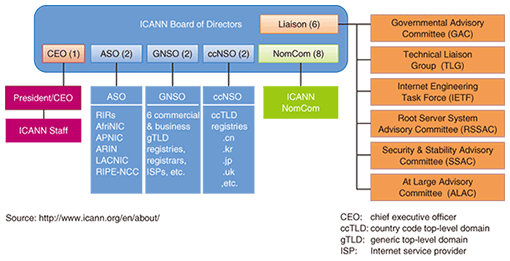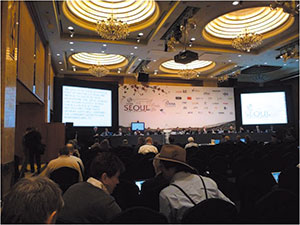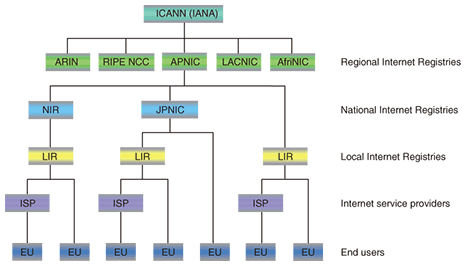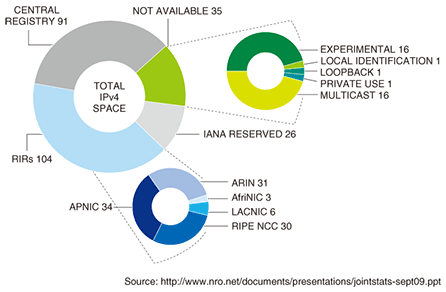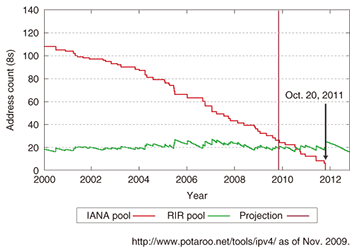 |
|||||||||||||||||||||
|
|
|||||||||||||||||||||
|
Global Standardization Activities Vol. 8, No. 3, pp. 42–47, Mar. 2010. https://doi.org/10.53829/ntr201003gls Internet Resource Management at ICANN and Regional Internet RegistriesAbstractThis article describes recent activities related to Internet resource management. An important aspect of safe and stable Internet operation is the management of Internet resources, such as IP (Internet protocol) addresses, AS (autonomous system) numbers, and domain names. These resources are uniformly managed by some organizations centered around ICANN.
1. IntroductionMany countries, machines, and organizations are connected to the Internet. Communications among hosts in this network requires the use of a common protocol, such as the IP (Internet protocol) suite. However, the various numbers used by the protocol should be managed uniformly. For instance, various numbers used by the IP suite (e.g., the number of upper-layer protocols and port numbers for TCP (transmission control protocol) and UDP (user datagram protocol)) should be unique throughout the world. The same is true of an IP address, which indicates an end host’s domicile, an AS (autonomous system) number, which identifies an organization on the Internet, and a domain name (FQDN: fully qualified domain name), which is the name of a host on the Internet. These numbers are managed by an organization called ICANN (Internet Corporation for Assigned Names and Numbers) [1]. 2. History of ICANNThe Internet has evolved from ARPANET (Advanced Research Projects Agency Network) in the USA, and the management of Internet resources used to be conducted by IANA (Internet Assigned Numbers Authority), which was funded by the US government. As the Internet spread worldwide, the need for a neutral organization for Internet resource management grew, and ICANN was established as an international private non-profit-making organization in October 1998. Even after it was established, however, there was criticism that it could not rid itself of its American origin because it had a contract with the USA (ICANN entered into a Joint Project Agreement with the US Department of Commerce) and is based in California. In October 2009, ICANN and the US Department of Commerce concluded a new contract, Affirmation of Commitments, in place of the Joint Project Agreement, and ICANN sought to shed its Americanness [2]. 3. Structure of ICANNThe structure of ICANN is shown in Fig. 1. The board of directors is composed of 15 people with voting rights and 6 nonvoting directors. Eight of the 15 voting directors are elected by ICANN NomCom (Nominating Committee) on the basis of applications, six are selected by three ICANN supporting organizations—two each by ASO (Address Supporting Organization), GNSO (Generic Names Supporting Organization), and ccNSO (Country Code Names Supporting Organization)—and the last one is the ICANN chief executive officer. The six nonvoting directors liaise with external organizations to promote smooth international adjustment and maintain stable operation of the Internet. They come from the Route Server System Advisory Committee (RSSAC), the Security & Stability Advisory Committee (SSAC), the At Large Advisory Committee (ALAC), Internet Engineering Task Force (IETF), the Technical Liaison Group (TLG, which liaises with ITU-T (International Telecommunication Union, Telecommunication Standardization Sector) and W3C (World Wide Web Consortium)), and the Government Advisory Committee (GAC), which is an organization where national governments can convey their opinions to ICANN.
4. Role of ICANNICANN’s primary role is to manage Internet resources. Its bylaws [2] describe its mission by stating that ICANN: 1) Coordinates the allocation and assignment of the three sets of unique identifiers for the Internet, which are a) Domain names (forming a system referred to as “DNS”); b) IP addresses and AS numbers; and c) Protocol port and parameter numbers. 2) Coordinates the operation and evolution of the DNS root name server system. 3) Coordinates policy development reasonably and appropriately related to these technical functions. 5. Policy development in ICANNPolicy discussion in ICANN is conducted on the basis of proposals submitted to the board of directors by the supporting organizations. In each supporting organization, a proposal for Internet resource management policy (at the ICANN level, policy is called global policy) is agreed through internal consensus and passed onto the ICANN board of directors. (The policy decision in ASO, one of the supporting organizations, is slightly different, as described later.) To engage with ICANN, it is of course possible to participate in its onsite meeting held three times a year. Other vehicles for public comments etc. are the mailing list related to ICANN and the ICANN website [1]. In particular, registration for the onsite meeting is free (as of 2009), and there are many sessions where participants give opinions directly to the ICANN board of directors (public forums etc.). Moreover, almost all sessions, such as supporting organization internal meetings and GAC meetings, can be attended by anyone. The ICANN board of directors meeting, which is usually held on the final day, is also open to participation: all the directors are on a stage in front of the other participants, and they discuss and make decisions on their own (Photo 1).
6. Recent discussion in ICANNAt the 36th ICANN meeting in Seoul, South Korea, from October 25–30, 2009, the introduction of internationalized domain names (IDNs) was approved by the board of directors [4]. This makes it possible to express domain names in the characters of many different languages instead of only in alphabetic characters as in the past. In Japan, the Japanese Domain Names Association [5] was established, and the introduction of “.ÆüËÜ” (dot jp written in kanji) is currently in progress. The approval of IDNs in ICANN supports the process of its introduction. In addition, a new “top-level domain” program is being examined for domain names. As before, requests for the addition of a new top-level domain name must be submitted to ICANN, which will then approve or disapprove. What is new is that top-level domains will no longer be restricted to public use such as “.biz”. The new system will accept names for private use such as “.itmedia” (company’s name), “.billgates” (individual’s name), and “.paris” (location name). All applications, including ones from enterprises and individuals, will be managed by ICANN-appointed registry operators, which distribute domain names to organizations, and passed onto ICANN for final approval. Nevertheless, a lot of applications are expected. Although this was initially scheduled to start in 2009, careful examination will be needed because a lot of opinions about the third edition of the application guidebook [6] were received from the public, so the start was postponed. The main discussion points are: * Problem of trademark rights (Trademark protection) * Problem concerning exclusion of illegal contract (Malicious Conduct) * Capacity problem of route server of DNS (DNS Route Server Scaling) * Problem of making registry and registrar separate (Registry and Registrar Separation) Each point covers many discussion items, and the various opinions will need to be taken into consideration and harmonized, which looks like taking more time. Related to IP address management, a global policy entitled “Global Policy for the Allocation of the Remaining IPv4 Address Space” [7] was approved by ICANN at the 34th ICANN meeting in Mexico City in March 2009. This policy is a countermeasure against IPv4 (Internet protocol version 4) addresses running out. It reserves one /8 (eight high-order bits) IPv4 address block for each Regional Internet Registry (RIR), so that when the IPv4 address stock in ICANN runs out, these final one blocks can be allocated. The aim of this policy is, by ensuring that there is one /8 IPv4 address block left for each RIR, to make it easy to take measures against IPv4 address exhaustion. 7. IP address and AS number managementICANN (IANA) has delegated the distribution of Internet resources such as IP addresses and AS numbers to the RIRs. There are five RIRs in the world, and they allocate necessary amounts of resources after examining and approving IP address requests from local Internet registries, such as Internet service providers, in each region. The management structure for IP addresses is shown in Fig. 2. Current allocation by ICANN is in /8 units, and when the number of available IPv4 address in an RIR pool decreases, two /8 blocks are allocated to the RIR (according to the distribution rule as of September 2009).
The RIRs compose the ASO of ICANN and convey their opinions about ICANN’s management policy for IP addresses and AS numbers. There are policy forums in each region where resource management policies (both regional and global policies) are discussed. When enhancement or revision of a global policy concerning IP addresses and AS numbers in ICANN is necessary, consensus of all the policy forums is needed. No special qualifications are needed to attend the policy forums, and anyone can join in the discussion. IP address users can initiate policy discussion, and this bottom-up process is the basis of ICANN policy discussion. 8. Status of IP resourcesBecause of the expansion of the global Internet, the demand for IPv4 addresses has been so high that address exhaustion is becoming a big problem. The current allocation status of IPv4 addresses reported at the 36th ICANN meeting is shown in Fig. 3, where IPv4 addresses are described in units of /8 blocks, so the IPv4 address length of 32 bits allows 256 blocks to exist. As of December 1, 2009, the remaining stock of IPv4 addresses was 26 blocks, with the others having already been allocated (91 blocks for the Central Registry in that figure were allocated before ICANN’s establishment, 104 blocks for RIRs were allocated by ICANN, and 35 unusable blocks (Not Available) that cannot be used because they are special IP addresses such as multicast addresses). A recent prediction for when the IPv4 address pool in ICANN will run out puts the date at October 2011 (Fig. 4) [8]. Similarly, 16-bit AS numbers will run out soon, and the predicted exhaustion date is November 2011 [9].
9. Policy trend in RIRsThe countermeasures expected to solve the exhaustion of IPv4 addresses and 16-bit AS numbers are the deployment of IPv6 (Internet protocol version 6) and the introduction of 32-bit AS numbers. Both plans have, from the technical standpoint, reached a practical level. Recent discussion of the Internet resource management policy reflects this situation. This section introduces the trend of discussions in the APNIC (Asia Pacific Network Information Centre) policy forum. 9.1 Policies concerning AS numbersThe distribution of 32-bit AS numbers has already started, and the policy for distributing AS numbers without distinction between 16 and 32 bits from 2010 has been approved. However, since the penetration of equipment that can handle 32-bit AS numbers is behind schedule, discussion to defer this policy for one year is ongoing in both the global policy of ICANN and the local policies of RIRs. The use of 32-bit AS numbers has already started, but it is still experimental. The deployment of 32-bit AS numbers to cope with the exhaustion of 16-bit AS numbers is an urgent need. 9.2 Policy concerning IP addressesRegarding IP addresses, policies to cope with IPv4 address exhaustion and promote IPv6 deployment are discussed at the same time. As mentioned above, there is a global policy for coping with IPv4 address exhaustion. Moreover, discussion about a policy that enables the transfer of IPv4 addresses among IPv4 address holders is also ongoing to improve the effectiveness of IPv4 address usage even slightly. As for IPv6 addresses, there have been comments that the difficulty of obtaining IPv6 addresses is one obstacle to IPv6 deployment, and a discussion of revising the IPv6 address policy, to make it easier to obtain IPv6 addresses, is ongoing. In the APNIC region, a new policy that allows IPv4 address holders to request and obtain IPv6 addresses without meeting any criteria will be implemented. 10. ConclusionInternet resource management is conducted through a bottom-up process, and anyone can contribute to it. Although Japan has one of the highest populations of Internet users in the world, its contribution to Internet resource management has not been very high. Japan should contribute not only in technological areas but also in policy areas. References
|
|||||||||||||||||||||








